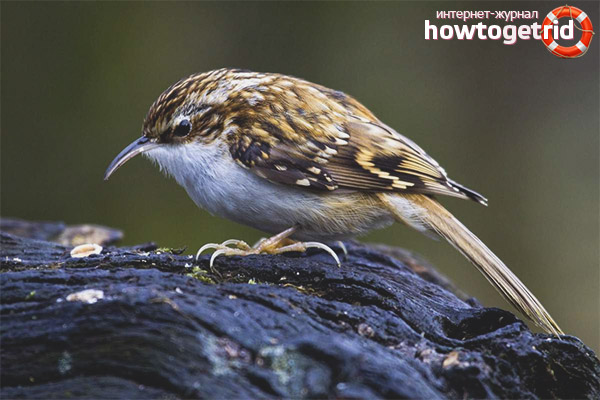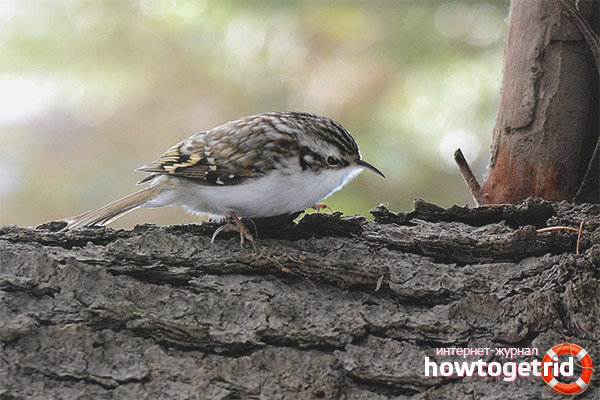The content of the article
An ordinary pika is a miniature-sized bird belonging to a passerine order. A distinctive feature of these birds is the squeak that they publish instead of tweeting. The individuals of this family are so small that in some cases people simply do not notice them. One can also note the movements of these individuals - spiral, vertical, along the trunk of the tree. Representatives of the family can look for food in the form of bugs and spiders all day long.
Description
- The bird belongs to the order of passerines and the family of pikas. By overall features, the birds do not exceed 12 cm. With a body weight of 10 g. maximum. By physique they are rounded and miniature, the neck is short. The head is small in size, flattened on the sides.
- These birds are distinguished by their non-standard beak. It is thin, squeezed, elongated and pointed at the edge. According to external data, the beak looks like a sharp sickle.
- The wings are medium in size, with a span of 20 cm. The tail is elongated, narrowed, trimmed in a straight line at the edge. Legs are short, with four clawed toes.
- By plumage, these representatives of the family are voluminous. The feathers themselves are loose, densified. In terms of its color of plumage, the abdominal region is pigmented in white, as is the lower region of the body. The insects are perfectly camouflaged among the vegetation.
- Their upper area of the body is covered with brown feathers with brown spots. There are some mottled areas. As for differences in gender, females from males are not much different.
- It is worth mentioning separately about the nutrition of these representatives of the family. They eat various insects, as well as their larvae. They love to eat pupae; in the winter, they try to diversify their diet with plant foods.
- They feed on the seeds of conifers. The individual receives almost the entire meal through the use of its beak. He will crawl into any cracks, and the bird can eat worms and bugs.
Nutrition and distribution
- The distribution of birds of the breed species represented is quite diverse. The individuals in this category have interesting taste preferences, which can vary depending on the season and age. They live in a forest part with deciduous trees. They are constantly looking for food, examining the bark of a tree with their sharp beak.
- Most often, these birds settle near the rivers, where there are many insects. Also found on lakes, in abandoned fruit or berry orchards, conifers (less commonly).
- Special attention should be paid to the process of obtaining food. The bird rests against the tree with its entire body, using the tail. Then she thrusts her beak into the holes and tries to get insects. If the woodpecker expects the food to enter the mouth itself, then the pika expends its energy and reaches the goal faster.
- Individuals of the breed group under discussion are very fond of bark beetles. Partly for this reason, the birds are called forest healers. When spring begins and the fall season ends, the birds already destroy a large number of pests that spoil the trees.
- If a bird finds trees rich in bugs, it will return to them every time. Will begin to examine the trunks from the bottom, gradually moving up. These individuals never remain hungry, because from an early age they are endowed with the ability to get their own food.
- When the winter season comes, birds have no opportunity to eat various insects. They begin to lean on the fruits of conifers, get seeds.
View Features
- Birds practically do not fly, they can only move from one tree to another.Individuals cannot fly long distances. They prefer to settle on a tree and dwell on it all day.
- Do not take into account the fact that individuals prefer to roam in packs. In everyday life, they still prefer to stay alone. Only when the cold sets in, individuals gather in groups and warm themselves.
- Interestingly, these birds can nest in the titmouse and inhabit a flock of another species. Thus, birds survive frosts, they have more chances to survive.
- Pisahuas belong to territorial birds, which carefully guard the terrain where they live. They try to discourage strangers from their open spaces.
- A distinctive feature is the fact that these birds are bold. They are not afraid of enemies, although at any moment they can be eaten. Individuals are fearless and loyal to their family.
- When the winter season draws near, all birds fall into a lazy state. Then spring makes itself felt, individuals literally come to life. They begin to sing, they are looking for new trees for catching meals, they can go down the path for a worm or bug.
- It was previously mentioned that the birds get food, and at this time they rest their tail against the trunk of a tree. Therefore, their tail always looks battered, may be broken or disheveled.
Breeding
- In the presented individuals, the mating season begins in early spring. It is worth noting that males at this time most of all show aggression and constantly fight. As soon as hassles begin, they can be identified without any problems by a characteristic squeak.
- Since April, birds have been trying to equip nests in tree hollows. Often the diameter of the entrance of the dwelling can reach up to 40 cm. Moreover, the depth of the nest can be up to 30 cm. It is also worth noting that often the dwellings are located at a short distance from the ground.
- An interesting fact is that the construction of a nest in birds takes about a crescent. Separately, it is worth mentioning that the upbringing of future offspring and the construction of a dwelling completely rests on the female’s shoulders.
- Most often, the considered species use cobwebs, moss, their own fluff, lichen and twigs as a building material. Hardworking birds strengthen their nests precisely from the side of the walls, and not the bottom of the hollow. It is for this reason that it can be said that the dwelling precisely hangs inside the tree, and does not lie in it.
- Around the beginning of May, in the nests one can already see the eggs of the considered individuals. It is worth noting that at this time the males are completely silent. At one time, the female may well bring about 8 eggs. Most often they are white with red spots.
- It often happens that masonry can be found in early summer. Such a factor mainly depends on climatic conditions and the habitat of the individuals in question. Young growth begins to hatch after half a month.
- Separately, it is worth noting that if the clutch was large, there is a possibility that several eggs will turn out to be lifeless. Weakened chicks may also suffer from larger brothers or from the parents themselves. The rest of the adults try in every possible way to feed the young, constantly carrying them food.
- As the young grow stronger, the chicks already begin to crawl through the tree. At the same time, they cling very tightly to the bark. As soon as the chicks notice their parents flying up, they begin to squeak very loudly. They also open their mouths wide awaiting food.
- Often, pikas try to breed two offspring in a row in one season. As previously mentioned, most factors depend precisely on climatic conditions and the habitat of the individuals in question. As soon as the chicks are on the wing, they try to settle close to their parents.
Interesting Facts
- It is worth noting that while singing, birds simultaneously emit two trills. Moreover, one of them is much higher than the second.
- When such birds move along the trunk of a tree, they use their own tail as a support. As a result, feathers are constantly erased and puffed.
- In especially cold weather, birds can stray into small flocks in secluded places just to keep warm and not to die.
- Often birds can inhabit various forests. But in most cases, they choose ripe and old stands. In such places they equip nests and get food without any problems.
The birds in question often lead a sedentary lifestyle if climatic conditions allow them. Only in some areas do individuals make small flights to warmer regions. As for the construction of nests, pikas build them in hollows and large tree cracks.
Video: Common Pika (Certhia familiaris)












Submit